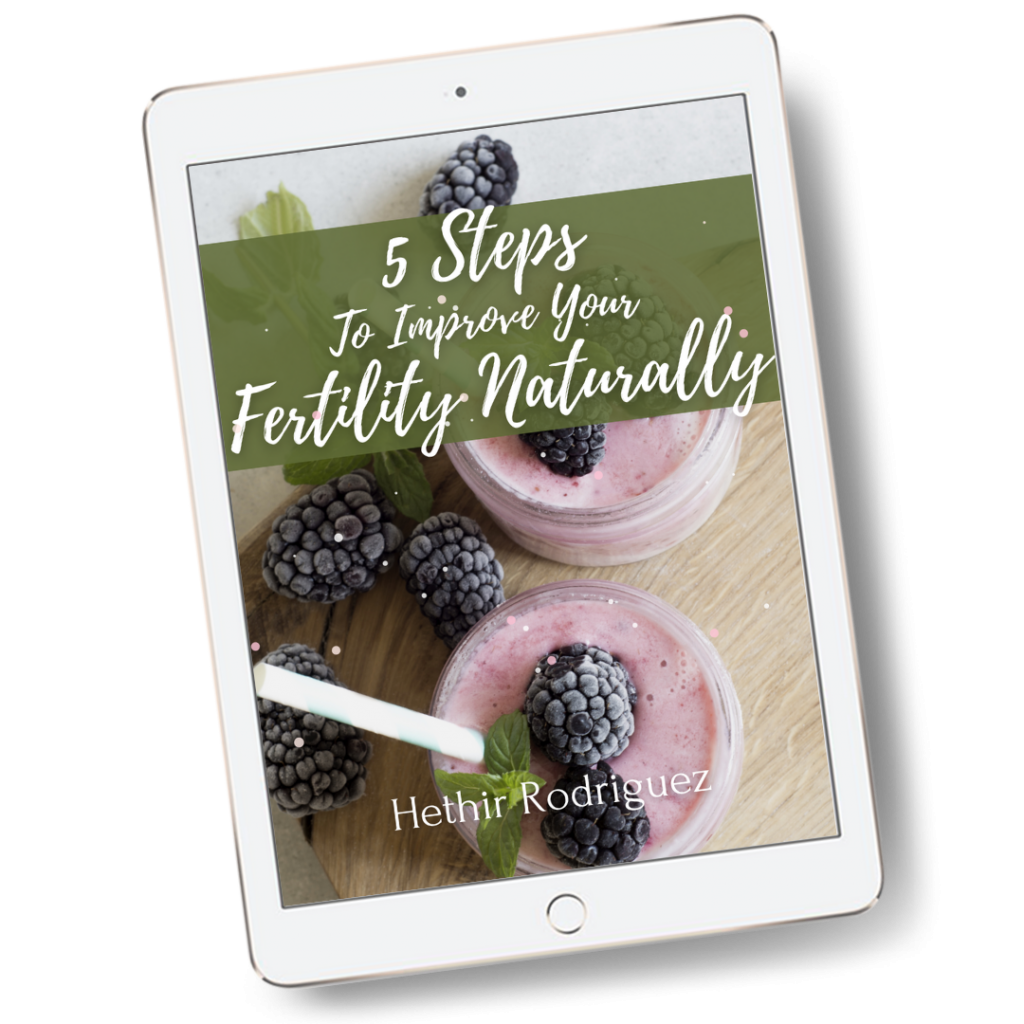Picture this: you wake up one morning and realize you are bleeding. Your last menstrual period just ended a week ago, and you aren’t due to start again until next month. Why are you seeing blood now?
This unexpected bleeding is considered mid-cycle spotting, or abnormal uterine bleeding. When experienced outside of your normal menstrual period, mid-cycle spotting can often be frightening. It brings up a range of emotions and questions you likely don’t know how to answer. Am I pregnant? Do I have a hormone imbalance? What is wrong with my body?
Mid-cycle spotting is one of the most frequently asked fertility questions. The concern is valid. As far as most of us learned growing up, you are only supposed to bleed during your period, not randomly throughout your cycle. There is some truth to this, but there are also a few exceptions. I hope to help you understand the different causes of mid-cycle spotting, learning to recognize what is normal and when it may be a sign that something isn’t quite right, which may warrant a trip to your gynecologist.
Causes Of Mid-Cycle Spotting
Abnormalities of the Cervix
Though rare, conditions of the cervix such as HPV, polyps, or cervical fibroids may cause some slight bleeding mid-cycle. If the mid-cycle bleeding is accompanied by pain in the cervical region, it would be best to have your gynecologist check this out. Very rarely, abnormalities of the cervix may be cancerous.
Endometriosis
Some, but not all women with endometriosis report mid-cycle spotting. The cause is not completely understood, but it is speculated that a disruption with hormone signaling may be the culprit. Excess endometrial tissue under the influence of hormones may be given disrupted signals, leading to breakthrough bleeding. The primary problem with endometriosis is heavy, painful periods.
Uterine Health Issues
Uterine polyps, fibroids and adhesions may all be suspect in cases of mid-cycle spotting. For polyps and fibroids, there is a hormonal imbalance component (discussed more below) and extra tissue known to be responsive to fluctuating estrogen. Inflammation is also a culprit, a natural cause of adhesions (scar tissue) formation.
One 2006 prospective cohort study presented at the 60th American Society for Reproductive Medicine annual meeting shared of 1009 women being evaluated by saline infusion sonohysterography (SIS) for uterine abnormalities and malformations as cause of their infertility, or who had abnormal uterine bleeding.
- 16.2% of the women in the infertility group were found to have uterine health issues; polyps, submucosal fibroids or adhesions, compared to 39.6% in the abnormal uterine bleeding group.
- 20% of women in the infertility group compared to 9.5% in the abnormal uterine bleeding group, had “uterine anomalies”, on of which being an arcuate of curved uterus near the fungus (top).
Implantation Bleeding
Implantation bleeding can be the most confusing of all, particularly for women currently trying to conceive. The hope is that the spotting they are experiencing is a sign of pregnancy, and not simply another period.
Up to 1/3 of women who conceive will experience implantation bleeding. This occurs at about 6 to 12 days post-conception. The scant discharge, tinted a light pink to brown, is the result of the trophoblast (tissue that forms around the fertilized egg) implanting itself in the uterine lining. The implantation disrupts some of the blood vessels in the uterus, which may cause slight bleeding. Because the bleeding can come as late as 12 days post-ovulation, many women mistake this bleeding for menstruation. Implantation bleeding is typically light and lasts anywhere from a one time occurrence, to very light bleeding over the course of two days, at most. It doesn’t become heavier like menstruation bleeding does and if it does, it could be a sign of early pregnancy loss. However, bleeding in early pregnancy can lead to a completely normal birth and healthy baby.
If you think you may be pregnant, take a pregnancy test. You can begin to test for early pregnancy with an at-home early pregnancy test at 7-10 days past ovulation.
Herbs That Have an Action on the Hormone System
When first introducing herbs that have an action on the hormonal system, some women may experience mid-cycle spotting. Many herbs we use to support reproductive health, have an action on the hormonal system, which is why they are so effective at aiding the body in correcting hormonal imbalances. The change to hormone signaling due to the introduction of herbs, may cause temporary mid-cycle spotting. This should only occur for the first couple cycles of use; as the body adjusts to the action of the herbs being taken. Though it may be worrisome, it is best to continue the herb/s. Herbs/herbal formulas are most effective when taken consistently for many months. This gives the body time to adjust to the action of the herb/s and for their benefits to be realized.
Hormone Balance Disruption
There is a delicate orchestra of hormones within each woman’s body that works to keep the menstrual cycle regulated. This is known as the hypothalamic-pituitary-ovarian (HPO) axis. Any type of disruption in this system may trigger mid-cycle spotting.
There are many reproductive health issues associated with HPO axis disruption, including, but not limited to, endometriosis, PCOS, thyroid disorders, luteal phase defect (LPD), uterine fibroids and ovarian cysts.
If you have never had a hormone profile test performed and you are experiencing recurring mid-cycle spotting, it would be a good idea to schedule a full panel of hormone testing with your doctor. This will help you to know if an imbalance in hormone levels may be the cause of the mid-cycle spotting. If you determine that a hormone imbalance is the cause, you can learn natural ways to support hormonal balance here.
Ovarian Cyst Rupture
If you experience a sharp pain on either side of your lower abdomen, followed by slight bleeding around the time ovulation should occur, it may be a ruptured ovarian cyst. Ovarian cysts are a sign of disrupted ovulation, which may cause difficulties in achieving pregnancy.
Note: See a doctor immediately if you have excruciating pain, nausea, vomiting and/or bleeding from the vagina during any point in your cycle.
Ovulation or Failure to Ovulate
This can be a tricky one. Why? Mid-cycle spotting can be a sign that you have ovulated, but it can also be a sign that you didn’t. Charting your basal body temperature (BBT) can help you to know if you are ovulating or not. The rise and consistent increase in BBT is a reassuring sign you have ovulated and progesterone levels are increasing.
Ovulation Some women experience mid-cycle spotting around the time just after ovulation has occurred. This is thought to happen due to the drop in oestrogen mid-cycle, prior to ovulation. Because progesterone levels have yet to rise, a small amount of the endometrium may be shed.Failure to Ovulate Mid-cycle bleeding in the presence of anovulatory cycles is due to lack of appropriate ovarian production of progesterone. In women with anovulatory cycles, the follicles begin to grow, though estrogen levels remain low, which means LH doesn’t surge and ovulation fails. When ovulation fails, no corpus luteum is formed and progesterone is not secreted. As a result, a lighter or shorter period may be experienced.
Progesterone Cream Use
Applying Natural Progesterone Cream at the Wrong Time in the Cycle If you use progesterone at the wrong time in your cycle, it may cause spotting to occur and may even cause the timing of your period to change. The best way to make sure you are using the cream at the right time is to calculate your progesterone start date by counting two weeks backwards from when your period is due. This is the most common time in the cycle for women to ovulate.Too Much Progesterone Cream Applying too high or too low a dose of progesterone cream may cause spotting to occur. This spotting may last only a day or two, or it may occur every day of application, up to menstruation, disrupting the timing of your expected period. The best way to avoid this from happening is to follow the directions on the product label. Better yet, you can consult with a healthcare practitioner who supports the use of progesterone cream. The progesterone test results will help them to determine an exact dose for your needs.
The Body is Adjusting to an Increase in Progesterone Levels Introducing progesterone may exacerbate estrogen dominant symptoms, such as spotting for a short time, as the body adjusts. When first introducing progesterone back into the body after an extended period of progesterone deficiency, the estrogen receptor sites ‘wake up’ (are stimulated), enhancing the action of estrogen for a short period of time. In this case, the spotting is a sign that the body is responding well to the progesterone, even though at the beginning it can exacerbate estrogen dominance symptoms. Your body should regulate over the following cycle. This is very common in women with PCOS, endometriosis, and anovulation. For a complete guide to progesterone cream use, click here…
Sexual Intercourse
The cervix becomes more sensitive around the time of ovulation, in preparation for pregnancy. Sexual intercourse may cause some slight damage to the cervix, producing light bleeding as a result. The presence of bright red blood tinged mucus after sexual intercourse is a common sign of this.
Other Less Common Causes of Mid-cycle Spotting:
- Hormonal Contraceptive Use
- Intrauterine Device (IUD)
- Ectropium from birth control pills
- Luteal Phase Defect (LPD)
- Excessive exercise
- Cervicitis
- poor nutrition
3 Steps to Resolving Mid-Cycle Spotting
1. Keep track of when it is happening
Determine what day in the cycle this is occurring, how long it lasts, note the color, amount and any other symptoms that coincide.
2. See your doctor
If you suspect a problem within your reproductive system, it is best to get some testing done to determine the cause. Discuss with him/her the effectiveness of saline infusion sonohysterography (SIS). Researchers concluded in the study noted above and published in the journal Fertility and Sterility that, “SIS should be considered routinely in the early stage of infertility and abnormal uterine bleeding investigation.”
3. Address the Cause
Once you determine the possible cause, talk to your doctor about medical options, while at the same time researching complementary alternative natural therapies to support your body, at home. We have information on natural, complementary and alternative therapies for most all of the causes discussed in this article.
- Romm, A. J. (2018). Botanical Medicine For Women’s Health. St. Louis, MO: Elsevier.
- Tur-Kaspa, I., Gal, M., Hartman, M., Hartman, J., & Hartman, A. (2006, September 27). A prospective evaluation of uterine abnormalities by saline infusion sonohysterography in 1,009 women with infertility or abnormal uterine bleeding. Fertility and Sterility. (Volume 86, Issue 6, Pages 1731-1735). https://doi.org/10.1016/j.fertnstert.2006.05.044. Retrieved from https://www.sciencedirect.com/science/article/pii/S0015028206030585
- Winder, K. (n.d.). Ovulation Symptoms – 10 Symptoms Of Ovulation. Retrieved from http://www.bellybelly.com.au/conception/ovulation-signs-symptoms-ovulation-days-ovulation-pain#.
- Symptoms of pregnancy: What happens first. (n.d.). Retrieved from: https://www.mayoclinic.org/healthy-lifestyle/getting-pregnant/in-depth/symptoms-of-pregnancy/art-20043853





